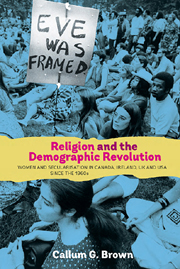 Religion and the Demographic Revolution
Religion and the Demographic Revolution 3 - Religious change
Published online by Cambridge University Press: 05 April 2013
Summary
Introduction
The religious changes in Britain, Ireland, Canada and the United States between 1960 and 2010 have been very great. These changes have not been even, nor at the same pace, across this territory. Yet there have been many common features. The shifts within Christianity, the re-shaping of religious life and the nature of worship, the sharpening of the division between conservative and liberal, and the rise of new religious movements and spiritualities, have been most significant and, in many respects, unprecedented in scale and impact. But these have been overshadowed in magnitude by the decline in the social significance of religion. Depending on nation, this has ranged from the seismic to the marginal. The four nations under principal review present different and instructive experiences of this decline. But they also offer a lot in common. In this chapter, we examine the statistical evidence bearing on their religious transformation.
There is no perfection in statistics of religion. Indeed, they present some of the best examples for teaching students of the need for care with social-science data. The problems include: changing definitions, absence of agreed definition of ‘membership’ or ‘adherent’, absent (and changing inclusion over time of) categories, changing denominational practices, inaccuracy and imprecision in counting systems, reliance on partial enumerators (often clergy), and, for comparative study between countries, different national practices and traditions in counting ecclesiastical strength.
- Type
- Chapter
- Information
- Religion and the Demographic RevolutionWomen and Secularisation in Canada, Ireland, UK and USA since the 1960s, pp. 71 - 126Publisher: Boydell & BrewerPrint publication year: 2012


